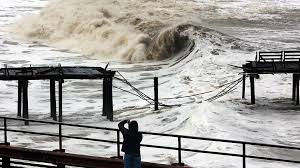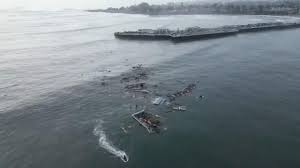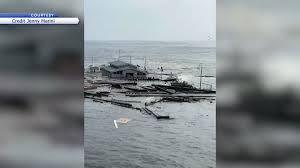The Santa Cruz Wharf Collapse: An In-Depth Analysis

On December 23, 2024, a significant structural failure occurred at the Santa Cruz Wharf in California, resulting in a partial collapse that sent three individuals into the Pacific Ocean. This incident has raised concerns about the structural integrity of coastal infrastructures, the impact of severe weather conditions, and the safety measures in place to protect both the public and the environment.
Overview of the Incident
The collapse transpired amid a high surf warning along the California coast, with waves battering the wharf and contributing to its structural failure. Eyewitnesses reported that a section of the wharf gave way, causing three people to fall into the ocean. Emergency responders swiftly arrived at the scene, rescuing two individuals, while the third managed to swim to safety independently. Fortunately, no serious injuries were reported.
Historical Significance of the Santa Cruz Wharf
Constructed in 1914, the Santa Cruz Wharf has been a central feature of the city's coastal landscape for over a century. Stretching approximately 2,745 feet into the Monterey Bay, it is renowned as one of the longest wooden piers on the West Coast. The wharf has historically served various functions, including facilitating cargo and passenger ship operations, supporting the local fishing industry, and acting as a hub for recreational activities and tourism.
Contributing Factors to the Collapse
Several factors likely contributed to the partial collapse of the Santa Cruz Wharf:
1. Severe Weather Conditions: The incident occurred during a period of intense storm activity, with heavy surf and strong winds exerting substantial pressure on the wharf's structure. The National Weather Service had issued high surf warnings for the area, indicating the potential for dangerous coastal conditions.

2. Structural Integrity: Given the wharf's age, concerns have been raised about the adequacy of its maintenance and its ability to withstand extreme weather events. While regular maintenance has been conducted over the years, the combination of aging materials and relentless exposure to marine elements may have compromised its structural integrity.
3. Ongoing Renovations: At the time of the collapse, the affected section of the wharf was undergoing a $4 million renovation project aimed at reinforcing and upgrading the structure. It is possible that construction activities, combined with the severe weather, played a role in the failure.
Impact on the Community and Environment
The collapse of the Santa Cruz Wharf has had several immediate and potential long-term impacts:
Public Safety: The incident has heightened concerns about the safety of public infrastructures, particularly those exposed to harsh environmental conditions. The swift response of emergency services prevented serious injuries, but the event underscores the need for rigorous safety protocols.
Economic Implications: The wharf is a significant tourist attraction, hosting numerous businesses, including restaurants, shops, and recreational services. The closure of the wharf for inspections and repairs could lead to economic losses for these establishments and the broader Santa Cruz economy.
Environmental Concerns: Debris from the collapsed section poses potential hazards to marine life and navigation in the area. Efforts will be required to remove debris and mitigate environmental impacts.
Response and Recovery Efforts
In the aftermath of the collapse, several measures have been initiated:
Structural Assessments: Engineers and safety inspectors are conducting thorough evaluations of the wharf to determine the extent of the damage and assess the overall structural integrity. These assessments will inform the necessary repairs and any additional reinforcement required to prevent future incidents.
Debris Removal: Efforts are underway to clear debris from the ocean to ensure the safety of marine navigation and protect the local ecosystem. This process involves coordination between local authorities, environmental agencies, and specialized contractors.
Public Communication: Authorities have issued advisories to keep the public informed about the situation, including the closure of the wharf, safety precautions, and updates on recovery efforts. Transparent communication is essential to maintain public trust and ensure community safety.
Historical Precedents and Structural Challenges
The Santa Cruz Wharf has faced challenges from natural forces in the past. Notably, the 1989 Loma Prieta earthquake caused significant damage to structures throughout the Santa Cruz area, including the wharf. The earthquake, with a magnitude of 6.9, resulted in severe damage due to soil liquefaction and ground ruptures, leading to the collapse of buildings and infrastructure.
Additionally, the Santa Cruz Harbor has experienced damage from tsunamis, such as the events in 2011 and 2022, which caused substantial harm to harbor facilities and required extensive repairs.
These historical events highlight the ongoing challenges in maintaining and reinforcing coastal infrastructures against natural disasters and environmental stressors.
Future Considerations and Preventative Measures

The collapse of the Santa Cruz Wharf serves as a critical reminder of the importance of proactive measures to ensure the safety and resilience of coastal infrastructures:
Regular Maintenance and Upgrades: Implementing comprehensive maintenance schedules and upgrading materials can enhance the durability of structures exposed to marine environments. Utilizing modern construction techniques and materials designed to withstand harsh conditions is essential.
Climate Change Adaptation: With the increasing frequency and intensity of storms due to climate change, it is imperative to incorporate adaptive strategies into infrastructure design and maintenance. This includes elevating structures, reinforcing foundations, and considering sea-level rise projections in planning.
Emergency Preparedness: Establishing robust emergency response plans, including regular drills and clear communication channels, can mitigate the impact of unexpected incidents. Engaging the community in preparedness efforts ensures a coordinated response during emergencies.
Conclusion
The partial collapse of the Santa Cruz Wharf is a multifaceted incident that underscores the vulnerabilities of aging coastal infrastructures in the face of severe weather events. It highlights the necessity for ongoing maintenance, structural assessments, and

.jpg)
.jpg)
.jpg)
.jpg)
0 komentar:
Posting Komentar